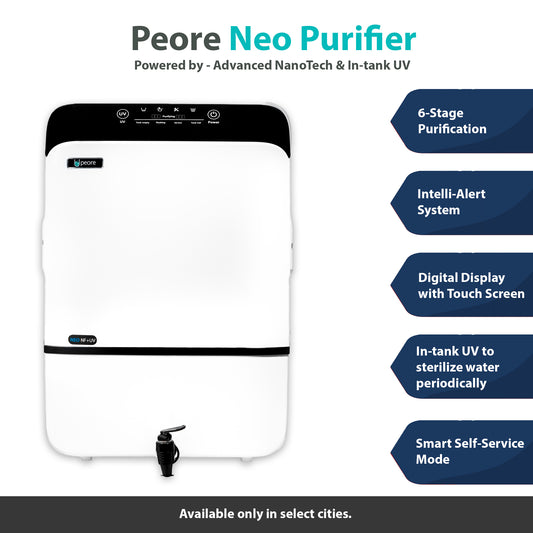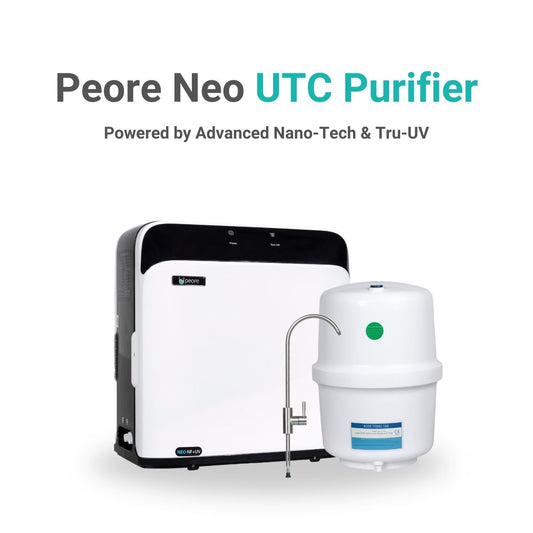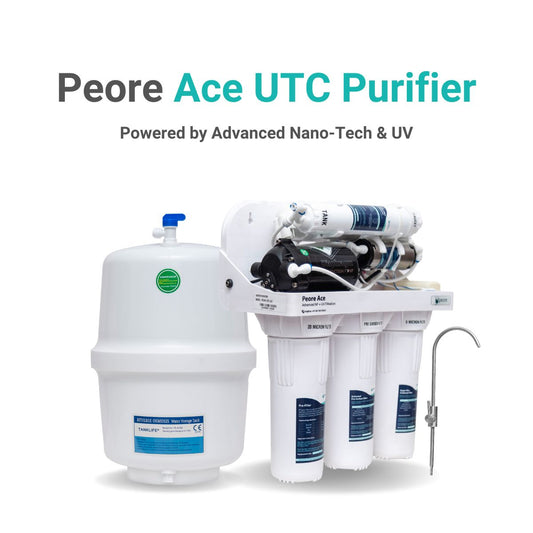Choosing the right water purifier for home can be confusing, especially with so many options available. From RO water purifiers to the latest Nanofiltration (NF) technology, each system is designed for different water sources and TDS levels.
Many people make the mistake of picking a purifier without considering their water source, TDS levels, and long-term maintenance costs. To help you make an informed decision, here are five crucial tips to keep in mind before buying a home water purifier.
1. Check Your Water Source & TDS Levels
Before choosing the best water purifier for your home, you need to understand where your water comes from and what’s in it. The first step is understanding your water source and TDS (Total Dissolved Solids) levels in water.
Common Water Sources & Their Impurities
🔹 Borewell/Tanker Water – Borewell water is untreated and may contain heavy metals (iron, arsenic, lead), excessive salts, and hardness-causing minerals (calcium, magnesium). It can also have a salty taste and leave white stains on utensils.
🔹 Municipal Water – Municipal water is largely treated water, supplied by local authorities. It may still contain chlorine, bacteria, organic impurities and sediments, especially if pipelines are old or poorly maintained.
🔹 River or Well Water – Typically has sediments, bacteria, and organic contaminants from natural and human activities. Since it’s untreated, it needs proper filtration.
How to Check TDS Levels at Home?
You can easily check the TDS levels using a TDS meter, available online or at local hardware stores. Here’s how:
1️⃣ Turn on the TDS meter and dip the metal sensor into a glass of water.
2️⃣ Wait for a few seconds until the reading stabilizes.
3️⃣ Check the TDS level: Check the reading on your TDS meter and let’s move on to the next step to understand which water purifier is suitable for your water.
P.S. You can purchase the TDS meter here
2. Understand Different Types of Water Purifier Technologies
Not all types of water purifier work for every water source. The right water purification technique depends on your water quality and TDS levels.
| Types of Water Purifier Technology | Best for | What it Removes | Mineral Retention |
|---|---|---|---|
| Reverse Osmosis (RO) | High TDS Water (TDS>1500) | Heavy metals, excess salts, bacteria, viruses | ❌Removes all minerals |
| Nanofiltration (NF) | Borewell & Municipal Water (TDS <1500) | Heavy metals, excess salts, bacteria, viruses | ✅Retains healthy minerals |
| Ultraviolet (UV) | Low TDS Water (<150)(Municipal) | Bacteria, viruses | ✅ No impact on minerals |
| Ultrafiltration (UF) | Low TDS (<150) & Visible Impurities | Sediments, bacteria | ✅ Retains minerals |
Knowing your water TDS helps you choose the ideal water purifier that removes contaminants while maintaining essential minerals.
As per WHO guidelines, the ideal TDS level for drinking water is between 100-300 ppm. Drinking low TDS water for prolonged periods can lead to weak bones, Cardiovascular issues, pregnancy disorders and even some kinds of cancers.
For example, using an RO water purifier on 500 TDS water can bring the output below 30 ppm, which isn’t suitable for long-term health. That’s why it’s important to choose a purifier that ensures both safe purification and essential mineral retention.
3. Don’t Blindly Choose RO - Consider Water Wastage & Sustainability
Many people assume RO water purifiers are the best choice, but that’s not always true. If your water TDS level is below 1500 ppm, a Nanofiltration (NF) purifier is a better option.
🔹 RO purifiers waste 3-4 liters of water for every liter purified, making them less eco-friendly.
🔹 NF Purifiers Waste 3X Less Water Than RO—it removes harmful contaminants while retaining essential minerals and wasting far less water, anywhere between 500 ml to 1.5 ltrs for every liter purified.
🔹 NF may not be as popular as RO yet, but it’s the future of water purification. If sustainability and efficiency matter to you, consider NF over RO.
✔️ Save water while ensuring purity! Explore NF Purifiers →
4. Factor in Maintenance & Filter Replacement Costs
A water purifier isn’t just a one-time purchase—ongoing maintenance is essential for long-term performance and safe drinking water. Many buyers overlook the annual maintenance cost (AMC), which can add up significantly over time.
🔹 Branded RO water purifiers typically have an AMC cost of ₹4,000–₹7,000, including multiple filter and membrane replacements.
🔹 Ultrafiltration (UF) purifiers have lower maintenance costs but are only suitable for low-TDS water, as they don’t remove dissolved impurities.
🔹 Nanofiltration (NF) purifiers, require lower maintenance, with AMC costs around ₹2,000-₹2,500, making them a more cost-effective choice.
💡 Pro Tip: Before buying a purifier, ask about annual maintenance expenses. Choosing a low-maintenance water purifier, like PEORE’s NF models, reduces long-term costs while ensuring high-quality purification.
5. Brand Reliability & After-Sales Support
When investing in a water purifier, consider the brand’s reliability, service network, and customer support.
🔹 Check customer reviews → A trusted brand should have positive feedback on product performance and service.
🔹 Availability of filters & spare parts → Ensures long-term usage without hassles.
🔹 Installation & after-sales support → A good brand should offer expert installation and prompt service assistance in your area.
🔹 Watch out for hidden charges → Some brands charge extra for installation, pre-filters, or mandatory accessories that aren't included in the listed price. Always check for transparency before purchasing.
Final Thoughts: Make an Informed Choice for Pure & Healthy Water
Buying a water purifier for home is a long-term investment in your family's health. By considering water quality, purification technology, and brand reliability, you can find the ideal water purifier that meets your needs.
💡 Quick Recap:
✅ Check Your Water Source & TDS Levels – Choose based on water TDS level for drinking water.
✅ Understand the Types of Water Purifier – UF for < 150 TDS, NF for < 1500, and RO for > 1500
✅ Factor in Water Wastage & Maintenance – NF and UF purifiers are more water-efficient.
✅ Trust a Reliable Brand – Ensure good after-sales support.
🚰 Still unsure? Let our experts help you choose the best water filter for your home. Contact us today for a free consultation or to get your water tested or call us at +91-8310459054 to talk to our water experts!









